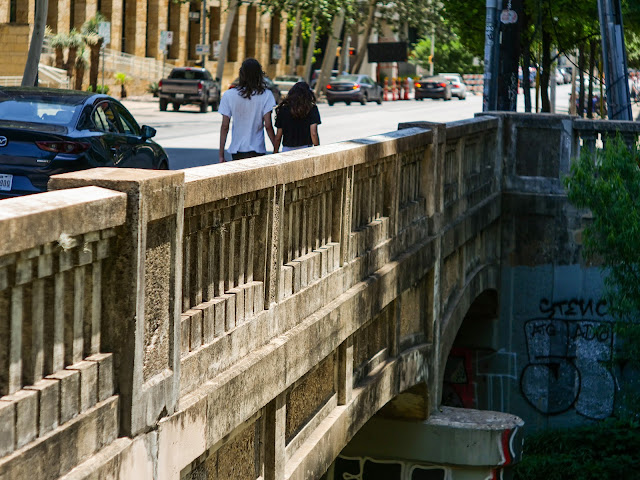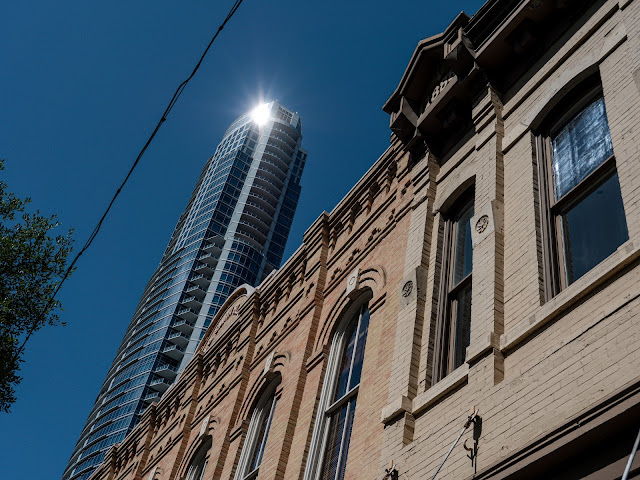
5.17.2022
The Leica CL and the Leica TL2 Exit the Camera Arena. Retired. Nothing lasts forever.

5.16.2022
Re-Visiting the equally ancient Olympus Pen FT 60mm f1.5 Lens. This time on a G9. A good excuse for walking around on a hot and steamy day.

5.15.2022
If it's a hot Sunday then it must be "Vintage Lens Day." Let's go for a walk and see how the ancient Olympus Pen FT 20mm f3.5 lens makes photos.
Many years ago, back in the early 1980's, I started buying Olympus Pen FT half frame cameras and lenses. They were cheap to buy in those days because people had not yet seriously embarked on niche camera collecting. Bodies in good shape were generally available for around $100 and most of the lenses were well under that price. One of the lenses I bought back then was laughingly cheap. I think I paid $23 for a well used copy of the G. Zuiko Auto-W 1:3.5 20mm Olympus lens. It had a slow aperture which made accurate focusing with the old cameras a bit of a mess. I tried to tame it but with the tech of the day it was, for me, a lost cause. I stuck it in a drawer and forgot about it for several decades until those two Zany companies, Olympus and Panasonic, engineered the micro four thirds system. It came complete with a short enough flange to sensor distance to accommodate an adapter and still allow my ancient Olympus Pen lenses to focus on infinity.
I started pulling old lenses out of the drawer but soon found that the early m4:3 cameras didn't do "punch in magnification" and that limited the usefulness especially of the shorter, slower lenses since their apparent depth of field made for sharp looking viewfinder images but woefully out of focus actual files.
The faster lenses such as the 40mm f1.4 and the 60mm f1.5 stayed out of the drawer and were used on m4:3 cameras as well as Sony cameras like the New-7 and the A7RII.
I recently re-upped with the m4:3 team and I checked out the focus magnification of the newer cameras and found it to be easy to use and well engineered to breath life back into the lenses that hadn't worked as well on earlier cameras. But I never got around to re-checking the 20mm f3.5 lens until this afternoon. Who knows why? I'd posit laziness but usually I'm pretty disciplined at getting to projects like this.
At any rate I put the lens on a well proven adapter ring, dressed for the 98° high temperatures, put on a bucket hat and took the G9 and the 20mm f3.5 Olympus Pen lens out for a walk. We are also accompanied by the Oly 60mm f1.5 but its performance today will be covered in a future blog post. Maybe.
The 20mm lens acts like a 40mm lens in a full frame, 35mm system. But one with an extra dose of depth of field. I noticed that light sources in the shots produced moderate flare and some aperture artifacting but I think that's to be expected since these lenses depended on their photographers using films with anti-halation backings and were not coated with the right coatings to reduce flaring with digital sensors.
I used focus peaking in addition to image magnification to really hone in on correct focus and I think that was the missing link in my earlier tests; no way to really fine tune at the taking apertures the accuracy of the focusing. Today though I was able to absolutely nail focus even while stopping down to f5.6 or f8.0 and focusing there. Sean Reid imagines that the greatest accuracy when focusing manual lenses such as these is to do your focusing with the lens wide open and then stop down to make the exposure. I, of course, disagree and think that with high magnification and nuanced focus peaking you can reduce focusing error caused by focus shift from stopping down when focusing at the taking aperture instead.
5.14.2022
Today I shot Raw + Jpeg. The Jpegs (previously posted) were in black and white while the raw files were.....raw files. I thought you might like to see what some of the stuff I shot looked like in color....

















































